Contents
Snow ball formation in cement rotary kiln | Infograph
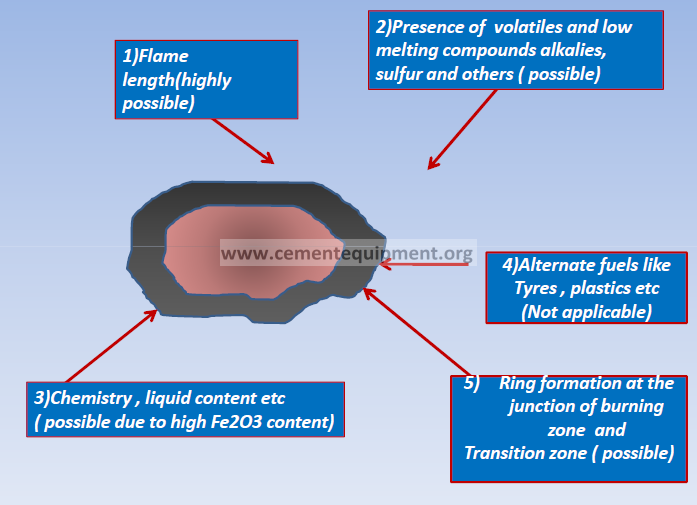
Formation of snow ball formation
Snow ball forms in transition zone where the temperature is around
1100 deg C +/- 50 . Low melting compounds like alkalies , sulfides, sulphites
Melt at this temperature and get agglomerated with the rawmeal and forms balls called snow balls. In forced kilns the temperature profile becomes flat ie., T between burning zone temperature and back end temperature is more. This is normally 400 to 450 Deg c . With low momentum flame it becomes 150 to 200 degc. If we use alternate Fuels like tyres , paint sludge and plastics etc they can add more low melting compounds in transition zone( not applicable here).But Fe2O3 melts at 1150 deg C.
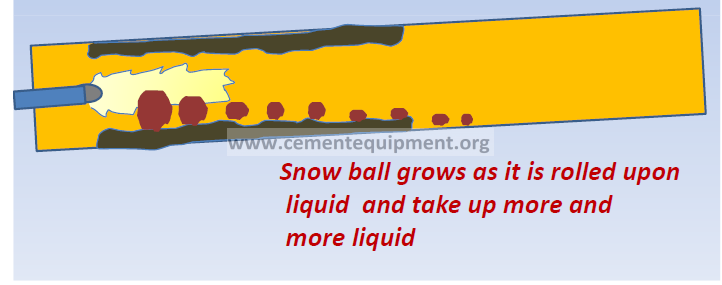
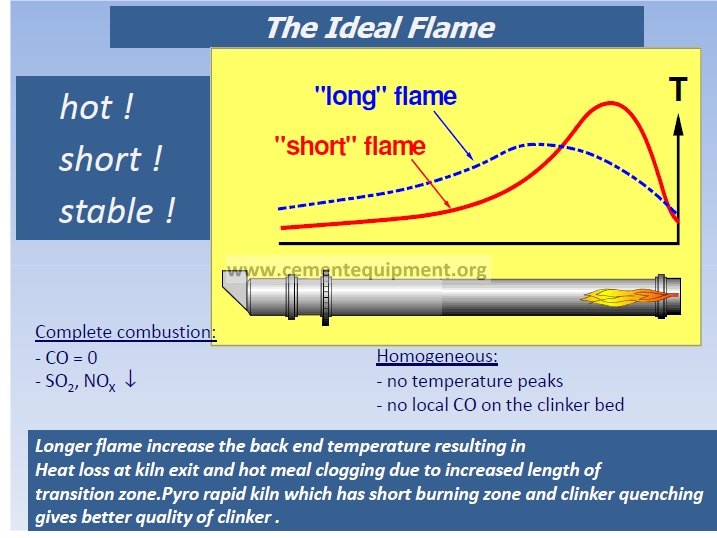
Burner Operation
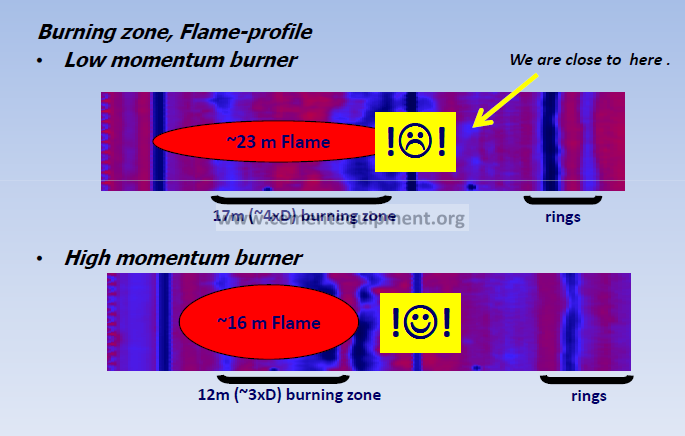
Optimisation of liquid
Normal liquid content in Indian conditions = 28 % +/-This liquid is calculated liquid derived from the formula

TToo mmaakkee aa ggoooodd cclliinnkkeerr tthhee lliiqquuiidd ccoonntteenntt mmuusstt bbee optimum and with right viscosity.
At our plant the liquid is 29 to 29.5 % and the coating is stable Hence liquid is optimum.
Observed often lumps discharging from the kiln.(High Fe2O3 content is one of the reasons)
In the cooler often observed big oval shaped balls with yellowish brown core.( size 300 mm to 500 mm) This is because of presence of sulfur and alkalies.
It has been found that the calculated liquid is different from actual estimated
by optical micros copy.AR should not be less than 1.2 whereas we have more than 1.2 and forms stable coating formation . If small coating falls and it is obstructed by coating ring, it melts , soaked inside clinker liquid, densify and becomes big balls. May be this is the right reason as the balls are solid.
The other types of balls one with yellowish brow core which are soft and
easily breakable , aught to form in transition zone. This is due to presence of alkalies, sulfur and low melting components .These balls when it is rotated for long time due to the obstruction of coating ring formed at the junction of
bbuurrnniinngg zzoonnee(( oorr ssaaffeettyy zzoonnee)) aanndd tthhee ttrraannssiittiioonn zzoonnee ggrrooww ggrraadduuaallllyy aanndd bbeeccoommeess big balls called snow balls. This I witnessed in Vikram cements before the spurrite ring In vikram-3 kiln. Petcoke with 6 % S , was the fuel and the sulfur was excess.

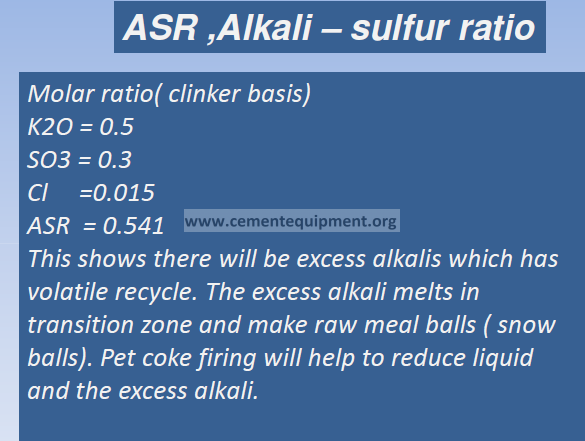
Stoppage due to clinker discharge got blocked with clinker balls.( 13-9-10)
If clinker coating lumps falls and unable to come out the kiln due to ash ring formation in the cooling zone it gets soaked In the liquid and they grow . If the Ring collapsed the balls roll out of the kiln and block the cooler discharge end. excessive amount of liquid promotes coalescence to form a solid dense balls which is blackish in color.
In Grasim cements at Reddipalaym when they used paint sludge as alternate ffuueell IInn 22000066 tthhiiss kkiinndd ooff bbaallllss bblloocckkeedd tthhee ffllaammee aanndd ccaauusseedd ttwwoo ddaayyss ssttooppppaaggee.. IItt was fragmented by pneumatic hammer.
At Ultra tech cements Awarpur I have witnessed 2.5 M dia ball came out of the kiln .The core part was brown and had rich in sulfur 8 % and 7 % alaklies.
In Vikam Cements , kiln -3,in the calciner retention time was only two minutes and in the calcining zone there was spurrite ring formation and in front of the ring there were lot of mud balls or snow balls accumulation.
Coating sample analysed by XRD – ring formation in end of the Burning zone at 28 M of Vikram Cements Kiln-3
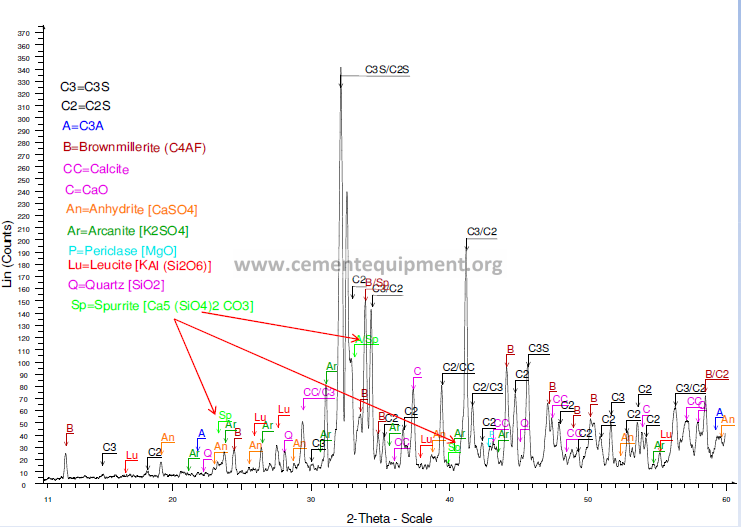
Conclusion
1. Make the flame shorter which reduces the back end temperature thereby Reduces the amount of low melting liquid. It reduces ring formation too.
2. Good oxidised condition reduces the alkali and sulfur cycle. The Volatile cycle enhances unwanted low melting liquid in the calcining and transition zone. Sulfo Spurrite ring promotes snow balls ( mud balls).Pet coke will reduce the excess alkali and the liquid . Poor flame makes char entrapment and makes the volatile active.
3. Fe2O3 must around 4 % and Al2O3 4.5 . We have inherent Fe2O3 in lime stone and it is difficult for us to reduce. If we can reduce from 4.5 to 4 this solves most of the problems.
4. Reduce the ring formation by using coating repellant fused magnesia spinel bricks at lower and higher transition zone .
5. Live with the problem and reduce the stoppage hours by using water jet machine with all the safety or Winchester Gun by well trained personnel.
6. Increase the rpm of the kiln which reduces meal retention time but for this we need high momentum flame to do pyro rapid burning. Otherwise free lime goes up. Mind raw meal retention time not less than 18 minutes. With the present operating rpm of 4.8 the retention time is 20.6 seconds. If we increase to 5 rpm
the RT is 19.6 seconds which is close to the acceptable value. If we go to 5.5 rpm the RT is 17.5 secs for which we need rapid burning with high momentum flame >2500 % m/s . This is the best option .
Thank you for your kind attention
K.P.PRADEEP KUMAR
SSrr.. GG..MM..OOppeerraattiioonn
Chettinad cements ltd
Ariyalur
dear Mr Kumar
thanks for your helpful information.
I need some articles or books (in pdf) related to snow ball and ring formation in cement factory. I would like to help me.